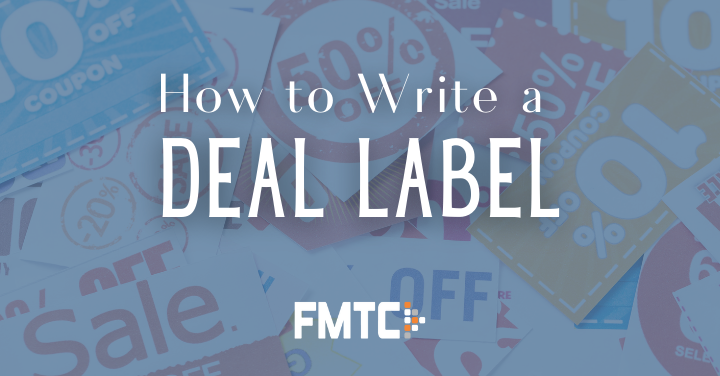A challenge for merchants is knowing how to entice customers to increase buyer-ready traffic and clicks. That is why knowing how to write a good deal label is a crucial step to competing in today’s e-commerce world.
Businesses have access to a large audience of potential customers, especially through affiliate marketing. If you’re wondering how to write a deal label, what makes a good deal label, or how deal labels help your business, you’ve come to the right place!
What Is a Deal Label?
A deal label is the text within a discount offer. Coupon sites, reward sites, and influencers use deal labels to make discounts and other promotions available to customers.
You may already be familiar with deal labels without even realizing it. If you’ve used sites such as Rakuten, you might have clicked on a deal like, “20% Off All Kitchen Appliances.” That is an example of a deal label!
How to Write a Deal Label
A good deal label consists of two items — the discount and the item on sale. However, if the following items pertain to your deal, they should also be included:
- The original price of the item and the price of the item through this deal
- Free gifts or bonuses with purchase
- Free shipping, along with minimum spending requirements (if any)
Here’s an easy formula to follow:
Perfect Deal = Discount + Item on Sale + Was/Now Pricing (if applicable) + Free Gifts/Bonuses (if applicable) + Free Shipping (if applicable)
This is how you can put this formula into action:
15% off (discount) all earrings (item on sale) with free shipping on orders $25+ (applicable free shipping)
Below are some examples of what not to do when creating a deal label — and what you can do to fix them!
Examples of Good and Bad Deal Labels
Bad Deal Label #1: All customers coming via Skeldon affiliate partner sites and purchasing a 12 month 30Mb, 50Mb, 150Mb, 500Mb and 1Gb or monthly rolling package 50Mb, 150Mb, 500Mb and 1Gb should get the affiliate partner deal
When reading this deal label, it’s difficult to understand what the actual deal is. Here’s a revised label:
Up to 40% off 12-month or Monthly Rolling Packages
Bad Deal Label #2: 15% off Enas Sight/Enas Sight pack/Enas Sight Wireless Outdoor Battery Security Camera
Deal labels shouldn’t use too many descriptive words. Here’s a concise alternative:
15% off select Enas Sight Security Cameras
Bad Deal Label #3: Add the Backstage Pass to your shopping cart, buy at least 1 item from the gaming range and additionally reach a minimum order value of £ 20. After entering the code, the Backstage Pass is reduced by 50%.
There’s no need to describe the purchase process and add filler words. Here’s a direct fix:
50% off Backstage Pass with Gaming Range Orders £20+
Bad Deal Label #4: Free Shipping on Tasse items
At first glance, this deal label looks alright. However, what does “Free Shipping” really mean? Is it free shipping on all orders? Or will a customer need to meet a minimum requirement? This is a better example:
Free Shipping with minimum $25 purchase of Tasse items
Benefits of a Good Deal Label
Good deal labels offer benefits to your business, your affiliates, and your customers.
Enhanced Credibility
By making special offers and following through with them, you increase your customers’ trust and loyalty to your brand. In receiving a special offer, customers see that your business keeps its word and delivers on its promise. On the other hand, poorly crafted deal labels can have the opposite effect and instill distrust and suspicion from customers.
Better Customer Experience
A good deal label is easily digestible. Customers will know exactly what you’re offering and can browse your shop with ease.
Beyond the Deal Label: Other Components to Consider
Terms (Exclusions or Restrictions)
Terms and conditions should not be included in the deal label. However, this information should be added in the Terms and Conditions field in the affiliate network’s template.
Example 1:
Deal Label: 10% off Women’s Clothes
For this deal, let’s say items from the fictional brand Good Jeans, as well as accessories, are not included. While you should not put these exclusions in the deal label, you would input the following in the Terms and Conditions field:
Except Good Jeans, Accessories not included.
Example 2:
Deal Label: 10% off Women’s Clothes over $100
The “over $100” in this deal label is a threshold, not part of the Terms and Conditions. Therefore, it can be included in the deal label itself.
(Tested) Coupon Codes
Coupon codes offer customers a direct path to action. Like Terms and Conditions, coupon codes shouldn’t be included in the deal label; they should be entered into the appropriate field in the affiliate network. They also need to be tested to make sure they are not defective.
Review your codes and look out for any typos or extra spaces. For example, if your coupon code is SUMMER21, make sure you don’t accidentally write SUMMER2021 or SUMMER 21.
If you don’t have the time or resources to check every coupon code, FMTC can help you! We test every coupon code to make sure they work properly before they get in front of your customers.
Good Deal Labels Lead to Sales
Deal labels are a great way to encourage customers to make a purchase. If you’re interested in streamlining your offers and promos, contact FMTC today to find out how we can help you earn more with your affiliate program.


